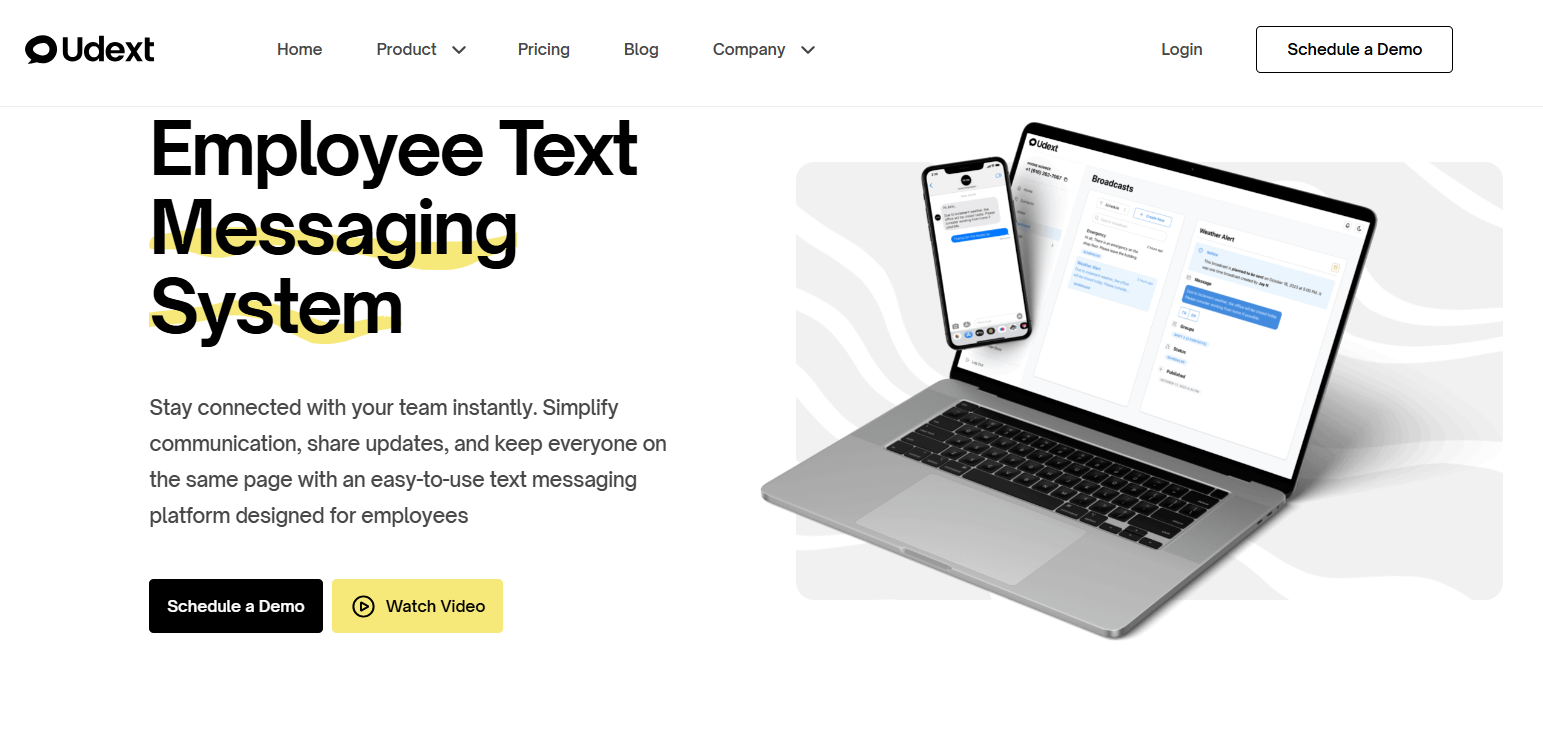
10 Expert Tips to Build an Impactful Company Communication Strategy


Poor communication costs companies more than money; it leads to missed deadlines, safety risks, and disengaged employees. According to studies, companies lose $62.4 million annually on average due to communication inefficiencies alone.
Remote teams, field workers, and non-desk employees face unique communication challenges. They lack consistent email access and work across different shifts and locations. Traditional communication methods simply don't reach these essential team members effectively.
SMS-based internal communication offers a powerful solution for reaching non-desk teams instantly. With 98% open rates and real-time delivery, text messaging bridges the gap between management and frontline workers.
In this blog, we share 10 expert-backed tips to help you build an effective communication strategy tailored for your workforce.
10 Tips to Build an Impactful Company Communication Strategy
An effective company communication strategy is the backbone of a productive and engaged workforce, especially when managing remote, frontline, or non-desk teams. Whether you share policy updates, safety alerts, or daily task reminders, how and when you communicate directly impacts your team's performance. These 10 expert tips will help you create a communication plan that's clear, consistent, and tailored to your workforce's real needs.
1. Understand Your Workforce's Communication Needs
Your communication approach depends entirely on who you're trying to reach. Desk workers have different needs from field employees or factory floor teams.
Deskless workers face specific communication barriers that traditional methods can't solve:
- Limited or no email access during work hours
- Scattered locations across multiple sites
- Varying shift schedules that make timing difficult
- Mobile-first work environments
Start by analyzing your workforce composition. Survey your teams to understand their preferred communication channels and current pain points. Use employee data to segment your audience based on roles, locations, and work patterns.
This analysis reveals gaps in your current company communication strategy and helps prioritize which channels will deliver the best results.
2. Choose the Right Communication Channels
Effective internal communication requires multiple channels working together. Email works well for detailed information, while instant messaging suits quick updates. In-person meetings remain valuable for complex discussions.
SMS stands out for urgent communications and reaching non-desk workers. Text messages achieve 98% open rates and deliver immediate visibility. Most employees read text messages within three minutes of receiving them.
Consider your message urgency and audience when selecting channels. Emergency alerts need immediate delivery through SMS. Policy updates might work better through email with SMS notifications.
Platforms like Udext centralize SMS communication across your organization. You can reach frontline staff efficiently without managing multiple systems or phone numbers. Give Udext a try and see how it helps your teams.
3. Set Clear Objectives for Communication
Define what success should look like for your teams before launching any communication initiative. Vague goals lead to ineffective messaging and wasted resources.
Your company communication strategy should target specific business outcomes like the following:
- Reduce absenteeism by 15% through better shift notifications
- Improve safety compliance by 25% with regular protocol reminders
- Increase employee engagement scores through better feedback collection
- Decrease turnover by improving manager-employee communication
Link each communication objective to measurable business metrics. This connection helps justify investment in communication tools and proves ROI to leadership.
Track progress regularly and adjust your approach based on results. Clear objectives also help you choose appropriate messaging frequency and content types.
4. Prioritize Message Clarity and Brevity
Complex messages confuse employees and reduce response rates. Keep your communications simple, direct, and actionable.
Follow a three-part message framework:
- Purpose: Why you are sending this message
- Information: Key details employees need to know
- Action: What employees should do next
SMS messages work best when they stay under 160 characters. Use clear call-to-actions like "Reply YES to confirm attendance" or "Click link for safety checklist."
Avoid industry jargon and technical terms that might confuse different employee groups. Test your messages with a small group before sending company-wide communications.
5. Centralize and Automate Communication Workflows
Fragmented communication tools create confusion and missed messages. Employees shouldn't need multiple apps to receive work-related information.
Centralized platforms eliminate communication silos and ensure consistent messaging. You can schedule shift reminders, policy updates, and emergency alerts from one system.
Automation saves time and reduces human error. Set up recurring messages like weekly schedules or monthly safety reminders for regular communications. Automated workflows ensure important messages reach employees even when managers are busy.
Udext's platform automates everyday internal communication tasks while maintaining a personal touch. You can schedule messages, set up approval workflows, and track delivery status from a single dashboard.
6. Enable Two-Way Communication
Top-down messaging creates disconnected workforces. Employees need ways to provide feedback, ask questions, and share on-ground insights.
Two-way communication builds trust and improves decision-making speed. Field employees often spot problems before management becomes aware of issues.
SMS surveys and quick polls gather employee input efficiently. Simple questions like "Rate today's safety briefing 1-5" or "Any equipment issues to report?" provide valuable feedback.
Udext enables two-way SMS conversations with complete message logs. Managers can respond to employee questions directly and track communication history for better follow-up.
7. Train Managers and Team Leads in Communication Best Practices
Managers serve as communication bridges between leadership and frontline employees. Poor management communication undermines even the best company communication strategy.
Train supervisors on proper messaging tone, frequency, and escalation procedures. They need clear guidelines about when to send urgent alerts versus routine updates.
Provide managers with templated messages for everyday situations. Consistent messaging reduces confusion and ensures essential information gets communicated correctly.
Cover these key areas in manager communication training:
- When to use different communication channels
- How to write clear, actionable messages
- Proper response time expectations
- Escalation procedures for urgent situations
Udext offers message templates that maintain consistency while allowing personalization for specific teams or situations.
{{see-udext="https://www.udext.com/symbols"}}
8. Monitor Communication Metrics and Engagement
Track key performance indicators to measure your communication effectiveness. Important metrics include delivery rates, response rates, and read receipts, where available.
Monitor these communication analytics:
- Message delivery success rates
- Employee response and engagement rates
- Time between message sending and employee action
- Feedback quality and frequency
Use dashboard analytics to identify communication gaps and opportunities for improvement. Low response rates indicate message timing issues or unclear call-to-actions.
Detailed message performance analytics that help refine your communication approach. You can see which messages work best with the right tool and adjust your communication strategy accordingly.
9. Continuously Improve with Feedback and Iteration
Build regular feedback collection into your communication strategy. Quarterly reviews help identify what's working and what needs adjustment.
Include employee representatives or field leads in communication planning. They understand ground-level challenges that might not be visible to corporate teams.
Test new communication approaches with small groups before company-wide rollouts. This testing reduces risk and improves message effectiveness.
Document lessons learned and share best practices across management teams. Communication improvement requires ongoing attention and refinement.
10. Create a Crisis Communication Plan
Emergencies don't wait for convenient timing. Your company communication strategy needs robust crisis communication protocols that work when normal operations fail.
Develop clear escalation procedures for different emergency types. Natural disasters require different responses than workplace accidents or security threats. Each scenario needs specific messaging templates and communication channels.
SMS becomes critical during emergencies because it works when internet connections fail. Cellular networks often remain operational when other communication methods go down.
Your crisis communication plan should include:
- Pre-written message templates for common emergency scenarios
- Transparent chain of command for message approval and sending
- Employee contact information, which is regularly updated and verified
- Backup communication methods if primary systems fail
Test your crisis communication system regularly through drills. Practice helps identify gaps before real emergencies occur. Train key personnel on emergency messaging procedures and ensure they can execute plans under pressure.
Udext's reliable SMS platform ensures emergency messages reach employees even during network congestion or partial system failures.
Company Communication Strategy Checklist
Before rolling out or revamping your company communication strategy, use this checklist to ensure you cover all the essentials. Whether you're managing a remote team, field workers, or office staff, these fundamentals help keep communication clear, consistent, and effective.
Even the best strategy needs ongoing tuning. Treat this checklist as a resource to revisit quarterly.
Now that you understand the key elements of effective internal communication, let's explore how the right technology platform can transform your communication strategy.
How Udext Powers Successful Company Communication Strategies

Udext's SMS-based internal communication platform addresses the challenges of reaching non-desk workers and distributed teams.
The platform supports essential communication functions:
- Real-time alerts for urgent updates and emergency notifications
- Team-wide announcements that reach all employees instantly
- Shift and attendance notifications to reduce scheduling conflicts
- Safety and compliance updates with delivery confirmation
- Two-way messaging with complete conversation logs
Udext integrates with existing HR and scheduling systems to automate routine communications. You can send personalized messages to specific employee groups while maintaining centralized oversight. See how it works →
Conclusion
Building an effective company communication strategy requires understanding your workforce, choosing appropriate channels, and continuously improving based on feedback. SMS communication bridges the gap between management and deskless workers, which traditional methods often miss.
The key lies in combining strategic planning with the right technology platform. Clear objectives, automated workflows, and two-way communication create engaged workforces that drive business results.
Start implementing these expert tips today and watch your internal communication transform from a challenge into a competitive advantage.
Ready to level up your internal communication? Book a demo today to see how Udext transforms team messaging for your organization.
{{see-udext="https://www.udext.com/symbols"}}
Need to improve your internal comms? Take a look at Udext!
"Out of the box, Udext has everything you need to elevate your internal communication. It’s incredibly easy to set up and use, with a straightforward interface and great customer support"
John D.
Director of HR at Apex Manufacturing


.svg)






